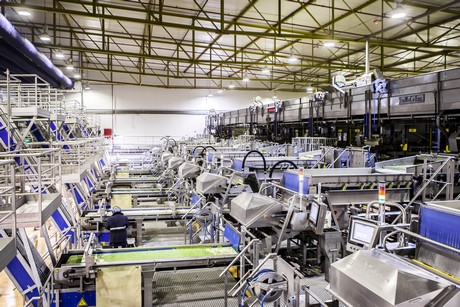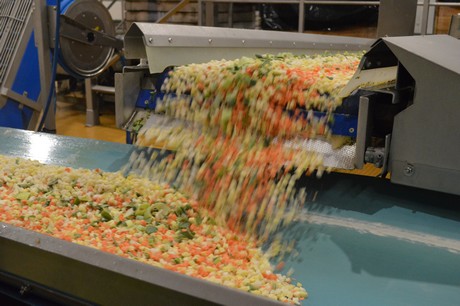Carrot, peas, beans and spinach are in the top of the production processed by the Flemish factories in large volumes. In total, the range has 27 productions. Last year, the company invested in a new tunnel freezer. “With this tunnel, we can freeze 20 tonnes of peas per hour,” Charles-Henri says. That amounts to around 14,000 tonnes of peas frozen per year. Because the tunnel freezer doesn’t have to be thawed out during this process, a high capacity can be achieved.

One-third mixed packaging
The products are stored in the cold store in large, wooden cubic crates that can handle the cold in the warehouse. The products are processed during the harvest, after which the product is available from the cold store for the remainder of the year. About one-third of the products leaving the factory are mixes of various vegetables. A separate hall of the factory holds a machine that mixes the products in the right proportion completely automatically. After that, the product can be packed in packaging varying between 250 grammes and 600 kilos.
Spread across Europe, Greenyard has 13 production locations within the Long Fresh division. Besides frozen products, tinned foods also fall into this division. However, with ten production locations, the frozen category is the largest. Within that group, the facility in Westrozebeke is the largest. All vegetables are grown within a radius of several dozens of kilometres of the production locations. This also decides the production in the factory. For example, a lot of broccoli is processed in Poland, while spinach and peas are the biggest products in Flanders. Thanks to its location near France, Northern French growers also supply their harvest to Westrozebeke. For the two locations in the UK, peas are the biggest product. This is also because of the prominent position peas take up on British menus.
Greenyard isn’t worried about Brexit regarding frozen products. With two production locations in the UK, where a lot of product is already being processed locally, the expected impact of leaving the EU won’t be too bad. “It will be more difficult for import products, but it also creates opportunities for British growers, as long as they adapt and become more competitive.”

Frozen not a competitor of fresh
“Logistically, Flanders has a strong position thanks to nearby ports,” Charles-Henri continues. The entire world can be supplied from Belgium thanks to the country’s good infrastructure. “From Poland, for instance, a lot is shipped via Rotterdam or Antwerp.” That connection to the world is important, because the largest sales markets are international. “Within the Frozen segment, the Benelux market is good for only two per cent of our turnover,” Charles-Henri says about the importance of the export markets. The European market shows a slight increase, although that is diminished by the potential of overseas markets. “In Brazil, for example, consumers are becoming more used to frozen vegetables,” he says. “That market has a lot of room to grow.” The number of households with a freezer is an important factor for the potential of a market.
Frozen products still have a less positive image than fresh vegetables. Unjustly, because studies show frozen vegetables retain their nutrients longer than fresh vegetables. “We don’t want to compete with fresh fruit and vegetables, that would just confuse consumers,” Charles-Henri explains. “We want to be an add-on to fresh with our frozen products.” He mentions the strong suits of frozen products regarding convenience.
Soups, sauces and smoothies
This focus on convenience products is reflected in their range. Last year, Greenyard invested in start-up Alberts, which developed a smoothie machine. “The machine uses frozen fruit, but has the perception of fresh,” Charles-Henri explains. “That way, frozen can be an add-on. It’s how we created an additional consumption moment.” Products that are difficult to process for consumers, such as pineapple, passion fruit and pomegranate, are preferred by the processor. These products are difficult to consume when unprocessed, particularly on the road or in the office.
In the development of new products, cooperation with supermarkets is sought. “We invite supermarkets to our location. Not to negotiate about prices, but to look at what consumers want, together.” From that starting point, they work together on new products. Soups, sauces and smoothies are an example of this. For example, a pumpkin-hazelnut soup was developed in cooperation with a customer. Another retailer was looking for an autumn soup, but the basil-tomato soup developed to this end turned out to be so successful, it’s now available year-round. The factory currently has a production capacity of 1 to 1.5 tonnes per hour for soups, but expansion plans have already been drawn up.
From harvest to final product in four steps: Harvesting and sorting
The spinach is harvested at the break of dawn. The growers bring the vegetables to the factory in Westrozebeke, where it’s processed into frozen spinach in just a few hours. During the season, about 300 tonnes of spinach arrive every day. This year, the spinach season started in April. After a few tricky days in March when temperatures dropped below freezing, the remainder of the season is going well. The first step in the process is sorting. Using wind and gravity, foreign objects, such as stones and earth, are separated from the leafy vegetables.
One-third mixed packaging
The products are stored in the cold store in large, wooden cubic crates that can handle the cold in the warehouse. The products are processed during the harvest, after which the product is available from the cold store for the remainder of the year. About one-third of the products leaving the factory are mixes of various vegetables. A separate hall of the factory holds a machine that mixes the products in the right proportion completely automatically. After that, the product can be packed in packaging varying between 250 grammes and 600 kilos.
Spread across Europe, Greenyard has 13 production locations within the Long Fresh division. Besides frozen products, tinned foods also fall into this division. However, with ten production locations, the frozen category is the largest. Within that group, the facility in Westrozebeke is the largest. All vegetables are grown within a radius of several dozens of kilometres of the production locations. This also decides the production in the factory. For example, a lot of broccoli is processed in Poland, while spinach and peas are the biggest products in Flanders. Thanks to its location near France, Northern French growers also supply their harvest to Westrozebeke. For the two locations in the UK, peas are the biggest product. This is also because of the prominent position peas take up on British menus.
Greenyard isn’t worried about Brexit regarding frozen products. With two production locations in the UK, where a lot of product is already being processed locally, the expected impact of leaving the EU won’t be too bad. “It will be more difficult for import products, but it also creates opportunities for British growers, as long as they adapt and become more competitive.”

Frozen not a competitor of fresh
“Logistically, Flanders has a strong position thanks to nearby ports,” Charles-Henri continues. The entire world can be supplied from Belgium thanks to the country’s good infrastructure. “From Poland, for instance, a lot is shipped via Rotterdam or Antwerp.” That connection to the world is important, because the largest sales markets are international. “Within the Frozen segment, the Benelux market is good for only two per cent of our turnover,” Charles-Henri says about the importance of the export markets. The European market shows a slight increase, although that is diminished by the potential of overseas markets. “In Brazil, for example, consumers are becoming more used to frozen vegetables,” he says. “That market has a lot of room to grow.” The number of households with a freezer is an important factor for the potential of a market.
Frozen products still have a less positive image than fresh vegetables. Unjustly, because studies show frozen vegetables retain their nutrients longer than fresh vegetables. “We don’t want to compete with fresh fruit and vegetables, that would just confuse consumers,” Charles-Henri explains. “We want to be an add-on to fresh with our frozen products.” He mentions the strong suits of frozen products regarding convenience.
Soups, sauces and smoothies
This focus on convenience products is reflected in their range. Last year, Greenyard invested in start-up Alberts, which developed a smoothie machine. “The machine uses frozen fruit, but has the perception of fresh,” Charles-Henri explains. “That way, frozen can be an add-on. It’s how we created an additional consumption moment.” Products that are difficult to process for consumers, such as pineapple, passion fruit and pomegranate, are preferred by the processor. These products are difficult to consume when unprocessed, particularly on the road or in the office.
In the development of new products, cooperation with supermarkets is sought. “We invite supermarkets to our location. Not to negotiate about prices, but to look at what consumers want, together.” From that starting point, they work together on new products. Soups, sauces and smoothies are an example of this. For example, a pumpkin-hazelnut soup was developed in cooperation with a customer. Another retailer was looking for an autumn soup, but the basil-tomato soup developed to this end turned out to be so successful, it’s now available year-round. The factory currently has a production capacity of 1 to 1.5 tonnes per hour for soups, but expansion plans have already been drawn up.
From harvest to final product in four steps: Harvesting and sorting
Cleaning and sorting
The vegetable is then transported inside via a conveyor belt. The spinach is cleaned once or twice, so that every last grain of sand is washed away. Optical sorting machines critically sort the product, so that they’re once again inspected to see if all foreign objects have been removed. After this step, the spinach is ready to be processed into the final product.
Blanching and freezing
After being heated at 85 to 90 degrees Celsius for a short time, the spinach is quickly cooled down and frozen at -20 degrees Celsius. The frozen spinach is cut into portions and stored in large cubic crates in a completely automated cold store. Processing is bound to the harvest. The products are only processed during the season, after which there should be plenty of volume to bridge the gap until the harvest next year.
Packing and supply
The cubic crates with frozen spinach are transported to the packing line from the automated warehouse. After a final inspection by an optical sorter and, if necessary, a manual inspection, the frozen spinach is weighed. The 14-headed multihead weighers weigh the measured amount per packaging. After one final inspection, for weight, among other things, the bags are placed in boxes. Via the automated palletiser the product heads for transportation. That step is also completely automated. A lorry is loaded at a temperature of -20 degrees Celsius within a few minutes, and the spinach is on the road towards consumers.







